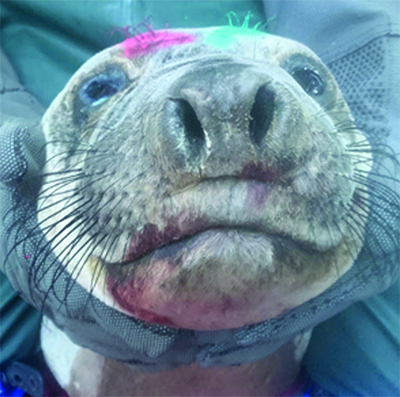An Elephant Seal’s Recovery from Stingray Barbs
By Heather Henderson, Marine Program Manager

During intake Examination on 5/11/22
On the afternoon of May 11th, patient #22-078 hauled out on Broad Beach in Malibu. Weighing 103 lbs. and measuring just over five feet long, few people might think to call the CWC Marine Mammal Rescue Team out for a wellness check. Fortunately for this four-month-old Northern Elephant Seal pup, a concerned member of the public did just that. When we arrived on the scene, the pup was resting face down near the waters’ edge. Initially he appeared to be a little underweight, but otherwise in fine shape, however something seemed off.
Upon closer examination, the team noticed facial swelling (particularly of the chin and muzzle) as well as moderate dehydration. We elected to pick up the pup and bring him to the center for care. During the intake examination, a stingray barb was discovered at the puncture site on the right lower chin. Once the two-inch-long barb was removed, the area was cleaned, and antibiotics and anti-inflammatory medications were prescribed. The elephant seal was also given supportive fluid therapy. The patient’s stomach was flushed to rule out ingestion of additional foreign substances and fortunately none were discovered.
The elephant seal was improving, but there was persistent swelling on the right side of his muzzle. One of the vibrissae (whisker) follicle endings looked to be infected. The culprit – a second stingray barb! Once removed, the tissue resumed a normal appearance and the vibrissae remained intact. Elephant seals have the most sensitive vibrissae of any animal due to the high number of nerve endings. This adaptation assists with effective prey detection at depth, thus defects in the nerve endings can have an adverse effect on their ability to locate sufficient food. Occasionally we see young elephant seals that encounter stingrays while learning to forage along the sandy ocean floor.

At pre-release Evaluation on 7/6/22
After a week of treatment, the facial swelling began to recede, and patient #22-078 showed an interest in fish. Upon arrival, the Marine Mammal Team had been feeding him a blended liquid nutritional feed. As he recovered, we enlarged his diet to include whole herring.
Pup #22-078 had a pre-release examination on July 5th – the puncture sites were fully healed, body condition was good, and his skin and fur coat were beautiful. This patient was gaining weight daily (an average of one kg/day) and was a robust 200 lbs. (double his intake weight) when he was released back to the Pacific Ocean in mid-July.
The simple act of noticing an ailing animal and taking the time to report them to us gave this seal a chance to heal and thrive. Thank you for caring about wildlife!
